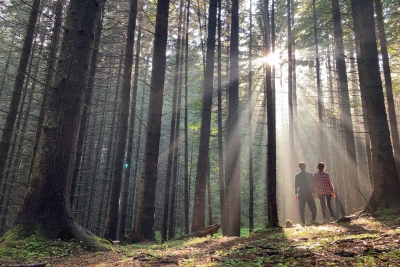
Forest bathing, better known as Shinrin Yoku in Japanese culture, is the practice of walking in the woods mindfully. In 1982, the Japanese Ministry of Agriculture, Forestry, and Fisheries created the term shinrin-yoku, which translates to “forest bathing” or “absorbing the forest atmosphere.” The practice encourages people to simply spend time in nature — no actual bathing required.
Anasuya Menon
Have you walked in a forest? Under the towering trees, with sunlight streaming down in thick long columns? Have you listened to the song of the birds or the sounds of a gurgling stream? Have you felt and probably smelt the fresh forest air? If you have done all of the above, you have forest bathed.
‘Forest bathing’ is nothing but. a mindful walk in the woods. The practice has its origins in Japanese culture, where it is called shinrin-yoku. The idea is to take in the forest through the senses. Being in the midst of nature refreshes the mind, energises and rejuvenates the body, says practitioners of forest bathing.
Re-connecting with nature
The concept has caught on in India, especially in the past few years with nature groups organising forest-bathing tours to help people reconnect with nature. “Forest bathing is not activity-oriented. It is a contemplative process, where the participants are guided to take in the forest through their senses. As a guide, I only help participants experience the energy of the forest,” says Dipika Sharma from Noida, who has been conducting forest bathing walks for groups in Delhi since 2019. “People are now increasingly aware of the therapeutic effect of nature especially after two years of being confined at home because of the pandemic,” says Dipika, who founded Forest Therapy, an organisation that conducts forest bathing tours.
Introducing children to forest bathing would help them form a lasting bond with nature, says Verhaen Khanna, commercial pilot-turned environmental activist, who has been conducting forest bathing workshops for school and college students.
“When children are out in the wild, their instincts are most alive. It instills a sense of curiosity in them. While on these walks, children usually ask me a lot of questions about the sights, smells and sounds of the forest. At times, it might be about a strange insect they have seen or it could be about a sound they heard. They become very aware of their surroundings,” says Verhaen. Being amid trees is also believed to boost immunity, says Verhaen, whose organisation, New Delhi Nature Society organises a variety of programmes for children starting from listening to birds to creating art, planting trees, mediation, tree climbing, yoga in the park and saving trees. “We have children as young as four years of age taking part. I have seen that children enjoy the time in the wilderness,” says Verhaen. The most receptive are children in the four to seven age group. “They are very attentive. They are curious about snakes and spiders. We ensure their safety, of course,” he adds.
The basic idea is to help children appreciate nature and understand how important it is to to be able to co-exist with nature. “We are also, in a way, helping them create memories. And the experience of a forest will stay with them for a long time,” Verhaen says.
In addition to building a bond with nature, children also develop their personalities by learning how to interact with others in the group.
Picture Credit : Google




